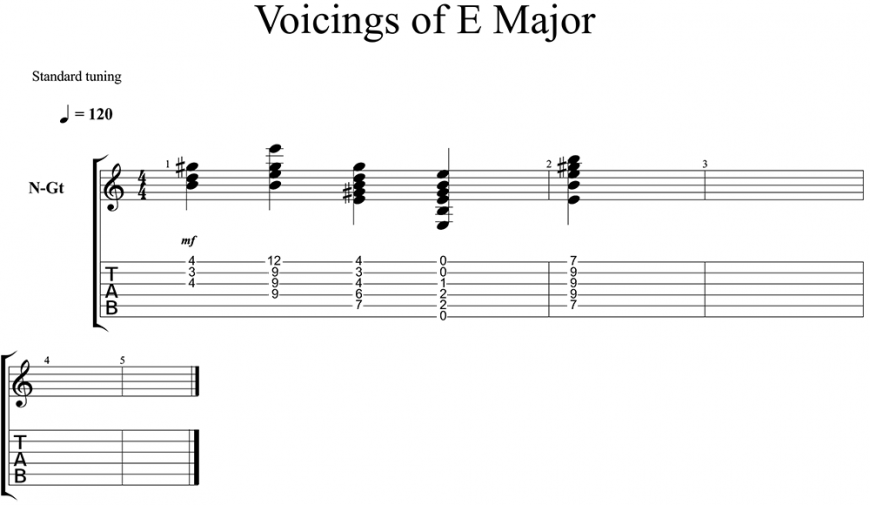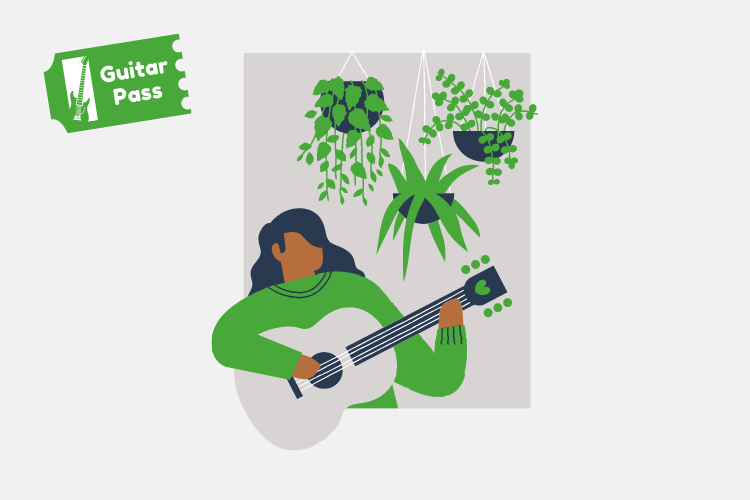Chordal Voicings on Guitar

This lesson will discuss new ways to play familiar chords up and down the neck of your guitar. If you know of only 2 or 3 positions to play an E major chord on the guitar this lesson will help you find fresh ways to fill up melody and rhythm with familiar chords.
Chordal Voicings is a fancy term referring to position of chords on the guitar neck. Most guitarists begin guitar learning barre chords and the standard E, A, D, C, and G shapes.
So if I were to ask any guitarist to play an E chord he/she would probably play it first as a barre chord with an open E string (the E shape), then as a barre chord beginning on the 7th fret of the A string (the A shape; if you consider the 7th fret as an open string then any barre chord based on the A string is an A shape chord), and then as a barre chord beginning on the 12th fret of the E string (another E shape). However, you can also use the D, C, and G shapes to play the E major Chord.
Click here to download the chart.
Let’s start with the D shape. Play a D chord in 1st position (fretting the 3rd fret on the B string and the 2nd fret on both the G and E strings), take this shape and move it up 2 frets. Strum only the first 3 strings and you are now playing an E major. Notice the notes on these 3 strings you have fretted (a B on the G string, E on the B string, and G# on the E string) and you’ll see that you are playing all 3 notes of the E major triad. If you take this same shape and move it up to the 10th fret on the B string you are now playing an A major! When using this shape all over the fretboard take note that the root of the chord is on the B string. Also note all the other triads that are near this chord shape. For instance, if you barre the top 3 strings you are now playing a minor triad, if you play the G string 2 frets higher than you originally fret it you have a different minor triad…. There are a few more triads within your reach that you will find if you explore a bit on your own!
Now time for the G shape. Everyone loves a G major in first position (with both E strings fretted on the 3 fret and the D, G, and B strings open) and you can use the top 4 strings from this shape to make other chords. To play an E major with the G shape barre the D, G, and B strings on the 9th fret and play the 12th fret on the high E string (if you play the 10th fret on the E string you get an E7). As you move this shape along the fretboard note that the root note is on the high E string. Also note the other chords near this new major chord shape.
Ok, now it’s time for the trickiest of all chord shapes, the C shape. To play an E major in the C shape play the 7th fret on the A string, 6th fret D string, barre the 4th fret on the G and E string, and play the 5th fret on the B string. It sounds gorgeous, but can be a bit cumbersome to play. If I’m playing a faster tune I generally use this position for arpeggios.
With these new chord positions new melodic possibilities become available to you.
Wiggle your pinky and ring finger around with the D and G shape chords and you will find the blues scale and modes all around you. Different chords are closer to your E major now if you are playing it with these new shapes, too. It’s also fun to play half a measure with the traditional voicing of a chord then moving to a different voicing for the last half measure; this technique is used heavily in ragtime and jazz.
I hope this lesson gives you some fresh ideas on playing your favorite chords and helps you find some new melodies out there. Once you become familiar with these chordal voicings you can start looking for chordal inversions. They can be pretty sneaky!
Michael Lentz is available for 1:1 lessons.
Find more Guitar Classes and Tutorials
Make real progress in live group guitar classes with great teachers in real time with the Guitar Pass.

Check out the guitar class pass options to see how it'd work for you >>




